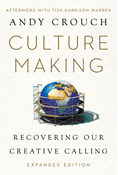A Conversation Between Tish Harrison Warren and Andy Crouch on Culture Making
"The only way to change culture is to create culture," says Andy Crouch in his bestselling book Culture Making. For too long, Christians have had an insufficient view of culture and have waged misguided "culture wars." But Crouch says we must reclaim the cultural mandate to be the creative cultivators God designed us to be.
In the new expanded edition of the book Crouch addresses the current landscape and forges a way forward for the future of culture making. Keep reading for a sneak peek into a new conversation between Crouch and Tish Harrison Warren from the expanded edition's new afterword. You can read more of this conversation in the expanded edition of Culture Making, available in September 2023.
Tish Harrison Warren (THW): A central focus of your discussion of culture is artifacts. There have been a lot of artifacts created since 2008. Which ones have most clearly "made culture"?
Andy Crouch (AC): The most obvious by far is the iPhone, which was released just a few months before Culture Making was published. I didn't write about it at all in the book partly because it was so new (the manuscript was nearly complete when the first iPhones appeared), and also because I had no idea it would be so profoundly transformational.
The smartphone is, without a doubt, the perfect illustration both of the central thesis of the book—culture really is a material reality—and of a certain weakness of the book as well.
THW: It is crazy that you were writing this book as the iPhone was launched, because it truly is such a culture-shaping artifact.
AC: Indeed. Especially because the iPhone is the ultimate artifact in some ways. It's like the monolith from 2001: A Space Odyssey—a superficially featureless thing that nonetheless, because of the way it lights up and the opportunities and worlds it opens up, ends up being world-reshaping.
A major preoccupation of mine in writing the book was the idea that it is not just disembodied ideas or values that change the world. It's when those ideas or values actually get instantiated or embodied in the world in concrete form—that's when you're really making culture.
We don't pay enough attention to how much technology—that is, the devices we've made and brought into the world in the last hundred years in particular—shapes our experience almost independently of the creator's intent. The ideas and values that drove Steve Jobs and the creators of the iPhone are sort of relevant—but sort of not—to the effect that it ultimately had.
It had far greater and different effects than they imagined.
There's this famous talk that Tony Fadell, who was on the team that designed the iPod and then worked on the iPhone, gave at the Design Museum in London. He said, "I wake up in cold sweats every so often thinking, what did we bring into the world?" By June 13, 2017, when he was speaking, he had three children, and he was specifically referring to their experience of the post-iPhone world.
The invention of the iPhone is very much a vindication of Culture Making. A thing that is made at scale can be as consequential as all the ideas ever thought.
At the same time, it illustrates a weakness. I think the book wasn't clear enough that these artifacts have to be embedded in institutions in order to be powerful. The truth is that if archaeologists dig up an iPhone ten thousand years from now—which they won't have trouble doing because they're all going to still be in landfills—but they don't know anything about Apple or about the Internet or electrical grids, it won't actually do to them what it has done to us.
In other words, artifacts are always part of broader systems. I talk about systems in the book, but I didn't talk enough about how these systems aren't exclusively embodied. They're patterns of human behavior and belief that transcend the ambitions of the artifact's maker and that don't always seem to be operating for our good.
We call these patterns institutions once they're established and up and running in human culture. When I buy an iPhone, I'm joining Apple's ecosystem. Our lives are now entwined with and embedded in Apple's vision of the world. But Apple is embedded in broader systems over which it isn't entirely in control. It's too simple to say that the artifact puts me under Apple's reign or rule, because Apple itself is under the rule of patterns that no one has designed, that no one has authorized from the top, at least not in the human sense.
Instead, these broader patterns are what we sometimes call emergent phenomena, phenomena that overtake not just me, the individual, but also the human corporations that make the artifacts. Artifacts gain power as they get scaled up into these broad patterns of human behavior and belief.
And our personal-size glowing rectangles seem to have tapped into such large-scale emergent systems that it's hard to name a competitor to the smartphone in terms of cultural influence. It pulled so much of our life into this emergent thing that is digital media. It offered us access to, but also a kind of indentured servitude to, this mediated world. The outlines of that world were there already—that's why the iPhone was a plausible invention—but that world didn't have the same power until the artifact came along.
THW: Let's talk about social media for a minute. One of the things that strikes me about social media—and about the Internet more generally—is that it messes with scale. In some ways, it operates on a very small scale. It enables connections between very small and idiosyncratic groups of people.
If I'm a guy in a small town that's super into jazz music, in 2001 it might have been really hard for me to find similarly situated people. But now I could easily find an Internet-based group of people who are very into jazz music. That's a positive example, but we can easily think of examples that are darker. If I am a white supremacist in a small town, I can easily find lots of other white supremacists on the Internet, even if everyone around me is morally opposed to that. So it creates these small-scale communities that then become global.
It feels like social media has enhanced our experience of the very small scale and the global scale. But any kind of intermediate institution—I'm thinking, for instance, of the family or the local church—has been diminished. Why should I go to my local church when I can just find the best church online? Why go to a prayer meeting when I could use a prayer app? A prayer app is a better example than online church, because even that online church is probably partly embodied somewhere. When you use a prayer app, you're connecting with Christians all over the world to pray for something, but then maybe you're not connecting with Christians in your neighborhood.
It seems that, in general, trust in institutions is low, and institutions are even weaker than when you wrote this book. But at the same time, there is a global scale to everything. How does scale work in a world where it seems like everything is global but intermediate institutions are failing?
AC: It's true that the world of simulation and mediated representation has gotten far more important to us than it's ever been to human beings. This was already happening with television and web browsers and web communities before 2008, but now so much of people's lives are spent in this world that does not actually make contact with the world of the five senses, of bodies, of things.
I actually think that this point connects to your observation, in that the disembodied nature of the digital world makes it almost inherently a private experience. Now, you can watch TikTok over someone's shoulder on their phone. Kids do this—they show each other videos, text threads, social media posts. But it's a very awkward experience. Digital media are optimized for individual consumption. In that way they are unlike movies and TV, their predecessors that were so defining for a couple generations of Americans, which, at least in principle, were designed to be shared.
Handheld devices, however, are meant exclusively for me, which makes the global and the individual scales the only relevant ones. And what they access is the interior life of the individual—my imagination, thoughts, desires, fantasies, anxieties. There is nothing buffering or mediating between the person and the global stage.
I think it's really interesting the way that the family in particular has been removed from a mediating position. At least since the Second World War in the United States, adolescence has involved a certain measure of private space. And within that space, kids definitely did develop and cultivate a sense of who they were apart from their parents and families. What's been really significant since the advent of the smartphone is both the extension of this domain of privacy to children, who now spend significant time online or on social media, and the intensification of adolescent differentiation from the family. Family culture—the things that only our family does together, the names that only we know for each other, the pains and the joys that we take in one another that only we know about— has been eclipsed.
THW: We're sharing more photos of our children with other people than ever. But maybe we're having fewer private conversations with our children. Is that what you mean?
AC: I suspect the number of those conversations is going down. But it's also their emotional salience. Our interactions with the real people around us have become less salient, less compelling than the interactions we can find when we go to that selective community online that checks all our boxes.






